Table of Contents
40+ DI Questions For IBPS Clerk Prelims 2021: The Institute Of Banking Personnel Selection is going to be conducting the IBPS Clerk 2021 Prelims exam on 12th, 18th, and 19th December 2021. This leaves the candidates with only a few days to uplift their preparations to ensure scoring maximum marks in the final examination. In the IBPS Clerk Prelims Exam 2021, the Quantitative Aptitude Section is challenging and trickiest of all. This section includes Data Interpretation(DI) which is time-consuming and requires the candidates to be very accurate with their answers. If prepared well the candidates can ensure good marks from the quantitative aptitude section. The best way to Prepare for the DI(Data Interpretation) questions is by practicing more and more questions. In this article, we will be providing you with 40+ DI questions for IBPS clerk 2021 Prelims exam, which will help you uplift your preparation for the examination, so keep reading.
40+ DI Questions For IBPS Clerk Prelims 2021
The quantitative aptitude section is said to be quite difficult. The maximum number of questions are asked from the Data Interpretation and it also contains more weightage. Preparing this section can help the students stretch their overall marks and qualify for the IBPS Clerk Main Exam 2021. Given below are the various types of formats in which DI questions are been asked in the examination.
- Bar Graph
- Tabular Form
- Line Chart
- Caselet Form
- Pie Chart
- Missing Data
We will now be looking at 40+ DI Questions for IBPS Clerk Prelims exam 2021 we cover all these questions in detail.
40+ DI Questions For IBPS Clerk Prelims 2021
Directions (1-4): Study the bar chart given below and answer the following questions.
The bar chart shows the number of books (in ’000) sold by 6 different companies (A, B, C, D, E & F) in two different years (2017 & 2018).
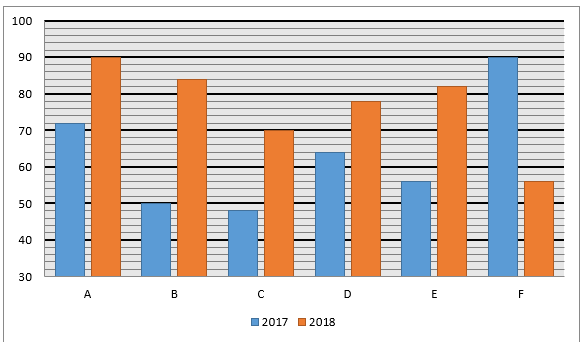
Q1. Find the ratio of books sold by A & C together in 2017 to books sold by E & F together in 2018.
(a) 20 : 23
(b) 15 : 16
(c) 3 : 8
(d) 10 : 17
(e) 4 : 5
Q2. The average number of books sold by A, B & D in 2017 is how much more or less than an average number of books sold by C & E in 2018?
(a) 19000
(b) 14000
(c) 12000
(d) 20000
(e) 16000
Q3. Books sold by A, C & F together in 2017 are what percent of books sold by A, D & E together in 2018?
(a) 96%
(b) 88%
(c) 80%
(d) 95%
(e) 84%
Q4. Total books sold by all 6 companies in 2018 are what percent more or less than total books sold by all 6 companies in 2017?
(a) 40%
(b) 20%
(c) 50%
(d) 10%
(e) 30%
Directions (5-8): Read the given information carefully and answer the following questions
The given table shows the production, export and per capita consumption of sugar in the town for five consecutive years.

Note:- (i) There is no import in any year
(ii) Consumption = Production – Export
Q5. Find the average quantity of sugar consumed in the town over the given periods? (in million kg)
(a) 104.6
(b) 103.8
(c) 105.2
(d) 104.9
(e) 104.8
Q6. In which of the following years was the percentage increase in the population over the previous year was the highest.?
(a) 2015
(b) 2016
(c) 2017
(d) 2018
(e) None of these
Q7. Find the ratio of population of town in 2015 to that in 2016?
(a) 93 : 91
(b) 104 : 101
(c) 101 : 99
(d) 102 : 97
(e) None of these
Q8. Which of the following year has the maximum consumption of sugar?
(a) 2014
(b) 2015
(c) 2016
(d) 2017
(e) 2018
Directions (9-14): Study the charts given below and answer the following questions.
Pie chart shows the % distribution of total employees of four companies (A, B, C & D) and line chart shows the % distribution of employees of each company in three different departments (i.e., Production, Finance and Marketing).

Q9. Find ratio of employees of company-A in production & marketing department together to employees of company-B in Finance department and employees of company-C in marketing department together.
(a) 18 : 25
(b) 4 : 5
(c) 11 : 14
(d) 12 : 17
(e) 20 : 27
Q10. Employees in finance department of company-A and employees in production department of company-B together are what percent of employees in marketing department of company-B?
(a) 45%
(b) 42%
(c) 58%
(d) 49%
(e) 53%
Q11. If ratio of male to female employees in company-A, B & C is 2 : 3, 11 : 9 and 4 : 1 respectively, then find approximate average number of male employees in company-A, B & C.
(a) 1706
(b) 1728
(c) 1684
(d) 1712
(e) 1738
Q12. Find total number of employees in production department of company-C & D together.
(a) 1320
(b) 1180
(c) 1250
(d) 1220
(e) 1160
Q13. Average number of employees in finance department of company-C & D is what percent more or less than employees in production department of company-B?
(a) 172%
(b) 164%
(c) 168%
(d) 160%
(e) None of the above.
Q14. Employees in marketing department of company-C & D together are how much more or less than employees in marketing department of company-A & B together?
(a) 870
(b) 850
(c) 830
(d) 840
(e) 860
Directions (15-19): Bar graph given below shows percentage of students out of total selected students who written UPSC exam in English language in five different years. Read the data carefully and answer the questions.
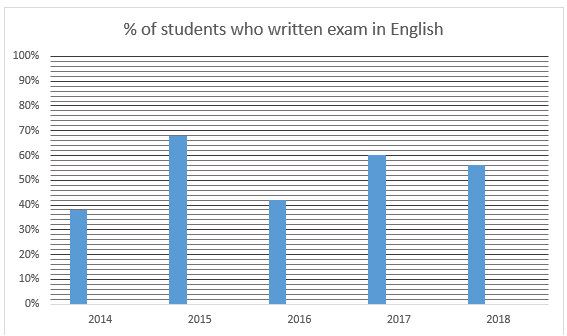
Note: – Exam can be written only in two languages either English or Hindi.
Q15. If no. of students who written exam in Hind in year 2017 are 450 less than no. of students who written exam in English in the same year and total no. of selection in 2017 are 10% less than total no. of selection in 2015, then find total selection in 2015?
(a) 2250
(b) 2325
(c) 2400
(d) 2500
(e) 2025
Q16. Ratio of total selection in year 2014 to that of 2016 is 2:3. Find ratio of students who written exam in Hindi and got selected in 2014 to that of in 2016?
(a) 62:87
(b) 31:43
(c) 11:19
(d) 7:11
(e) 62:89
Q17. If total no. of selection in each the given year are same and average no. of students who written exam in English and got selected in 2014, 2015 and 2018 are 540. Find no. of selection in each year?
(a) 1200
(b) 1000
(c) 1500
(d) 800
(e) 900
Q18. If no. students who written exam in Hindi and got selected in 2015 and 2018 are equal, find ratio of total selection in 2015 to 2018?
(a) 5:4
(b) 7:8
(c) 17:14
(d) 11:8
(e) 17:8
Q19. If in 2014 and 2017 no. of students who written exam in English and got selected are 380 and 480 respectively, find total no. of selection in 2017 are how much percent more/less than that of 2014?
(a) 20% less
(b) 25% more
(c) 20% more
(d) 25% less
(e) 15% more
Directions (20-24): Pie chart given below shows percentage distribution of votes which were cast in favor of six political party (A, B, C, D, E and F) in phase 6. Total valid votes are equal to 100000, out of which only 80% of the votes have been cast in that phase. Further, 10% of the votes cast were cast in favor of those who are not representing any of these 6 parties.
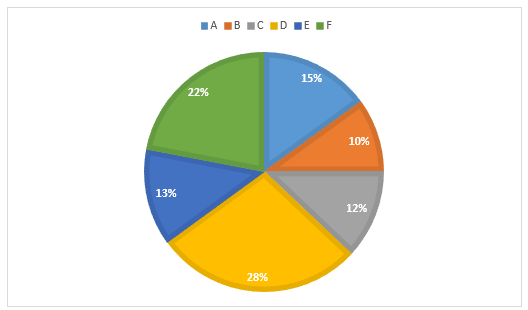
40+ Important Simplification Question for IBPS PO Prelims 2021: Check Here
Q20. Difference between highest valid votes and lowest valid votes which were cast in favor of any of these six party is what percent of average no. of valid votes which were cast in favor of A, C and E?
(a) 100%
(b) 120%
(c) 80%
(d) 135%
(e) 125%
Q21. Valid votes cast in favor of A & B together is what percent more or less than valid votes cast in favor of D & F together?
(a) 50%
(b) 80%
(c) 40%
(d) 20%
(e) 70%
Q22. What is the difference between no. of valid votes which were cast in favor of party A and F?
(a) 4060
(b) 5040
(c) 4160
(d) 4400
(e) None of these.
Q23. What is the ratio of average of valid votes which were cast in favor of party B and E to total valid votes cast in favor of those who are not representing any of these six party?
(a) 200:207
(b) 207:197
(c) 197:200
(d) None of these
(e) 207:200
Q24. No. of valid votes which were not cast are approximately what percent more than no. of valid votes which were cast in favor of party B?
(a) 182%
(b) 178%
(c) 167%
(d) 157%
(e) 190%
Directions (25-29): Study the table given below and answer the following questions.
Table shows the number of girls in 5 different schools (A, B, C, D & E) and ratio of boys & girls in these schools.
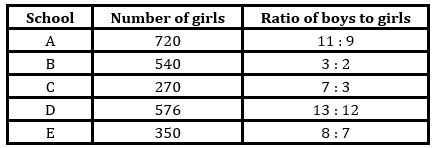
Q25. Find ratio of boys in school – A & E together to boys in school – B & C together.
(a) 3 : 5
(b) 11 : 14
(c) 8 : 9
(d) 1 : 2
(e) 6 : 11
Q26. Average number of girls in school – B, C & D is what percent of average number of students in school – A & D?
(a) 50%
(b) 15%
(c) 35%
(d) 20%
(e) None of the above.
Q27. Students in school – B are how much more than girls in school – E and boys in the school – D together?
(a) 388
(b) 382
(c) 394
(d) 376
(e) 374
Directions (28-32): Pie chart given below shows percentage break up of revenue generated by six different items (LED, refrigerator, cable, laptops, mobile and calculator) of a shop in a month? (assume shop sell only these six items)
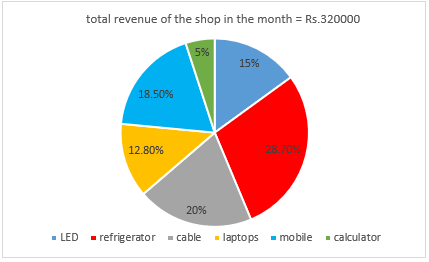
Q28. Revenue from refrigerator is how much more than revenue from laptops?
(a) Rs.40960
(b) Rs.64000
(c) Rs.59200
(d) Rs.50880
(e) Rs.48000
Q29. What is the difference between central angle (in degree) formed by revenue from refrigerator, laptops and mobile together and revenue from cable?
(a) 144
(b) 108
(c) 72
(d) 180
(e) 240
Q30. Revenue from mobile is how much percent more than revenue from calculator?
(a) 370%
(b) 225%
(c) 250%
(d) 275%
(e) 270%
Q31. If total 4 LED were sold in that month and selling price of each laptop in that month is Rs.5120, find no. of laptop sold is how much percent more than no. of LED sold in that month?
(a) 50%
(b) 100%
(c) 25%
(d) 75%
(e) 200%
Q32. What is the total revenue (in Rs.) from cable and mobile together?
(a) 223100
(b) 123000
(c) 123200
(d) 148200
(e) None of these.
Directions (33-37): Table given below gives information about no. of students who appeared for a banking exam in a lab in three different shifts of five days. Read the data carefully and answer the following questions?

Q33. No. of students appeared on shift1 and shift2 together on day2 are how much percent more or less than no. of students appeared in shift3 on day1 and day3 together?
(a) 11.11%
(b) 9.09%
(c) 8.25%
(d) 11.33%
(e) 9.11%
Q34. If 40% of students appeared in shift2 of day4 are girls, find no. of boys appeared in shift2 of day4 are how much less than students appeared in same shift of day5?
(a) 190
(b) 105
(c) 85
(d) 90
(e) 120
Q35. What is the average no. of students appeared in shift3 of all five days?
(a) 800
(b) 820
(c) 810
(d) 815
(e) 805
Q36. If 0.4% and 0.75% of students appeared on shift1 and shift3 of day1 and day5 respectively cleared the exam, find ratio of students who cleared exam in shift3 of day5 to that of in shift1 of day1?
(a) 1:2
(b) 3:2
(c) 4:3
(d) 2:3
(e) 2:1
Q37. No. of students appeared in shift2 of day4 are how much percent of no. of students appeared in shift3 of the same day?
(a) 45%
(b) 87.5%
(c) 62.5%
(d) 75%
(e) 60%
Directions (38-42): Study the pie-charts carefully and answer the following questions.
1st Pie-chart shows the percentage distribution of AC (split AC + window AC) and 2nd pie-chart shows the percentage distribution of Split AC sold by four different stores (X, Y, Z and K)

Q38. Total AC sold by Store X is what percent more or less than the window AC sold by store Y?
(a)25%
(b) 35%
(c) 30%
(d) 20%
(e) 40%
Q39. What is the ratio of total AC (split + window) sold by store Z to window AC sold by store X?
(a)22:17
(b) 22:13
(c) 21: 17
(d) 21:13
(e) None of these
Q40. Window AC sold by store K is what percent of the total AC (split + window) sold by all store together?
(a)14.4%
(b) 26%
(c) 19%
(d) 16.2%
(e) 12.5%
Q41. If store Y sold each window AC at Rs 28000 then find the total money obtained by store Y by selling all the window AC?
(a) 2.48 crore
(b) None of these
(c) 16.8 lakh
(d) 1.68 lakh
(e) 1.68 crore
Q42. What is the average of split AC sold by store X, Y and K?
(a) 148
(b) 288
(c) 248
(d) 242
(e) 324
Solutions
Candidates can check the solutions of all the DI questions mentioned above from the table mentioned below.
| Question
Number |
Correct
Option |
| 1 | A |
| 2 | B |
| 3 | E |
| 4 | B |
| 5 | B |
| 6 | A |
| 7 | C |
| 8 | E |
| 9 | D |
| 10 | A |
| 11 | D |
| 12 | D |
| 13 | B |
| 14 | E |
| 15 | C |
| 16 | D |
| 17 | A |
| 18 | B |
| 19 | D |
| 20 | A |
| 21 | D |
| 22 | A |
| 23 | B |
| 24 | E |
| 25 | B |
| 26 | C |
| 27 | E |
| 28 | D |
| 29 | A |
| 30 | E |
| 31 | B |
| 32 | C |
| 33 | B |
| 34 | C |
| 35 | B |
| 36 | E |
| 37 | B |
| 38 | A |
| 39 | B |
| 40 | D |
| 41 | E |
| 42 | B |
IBPS Clerk Prelims Exam Pattern 2021
The IBPS Clerk prelims exam 2021 consists of 3 sections for which candidates will get 60 minutes to complete the examination. The detailed IBPS Clerk prelims exam pattern 2021 is provided in the table below.
| Sno | Section | Questions | Marks | Time duration |
| 1 | Reasoning Ability | 35 | 35 | 20 Min. |
| 2 | Numerical Ability | 35 | 35 | 20 Min. |
| 3 | English Language | 30 | 30 | 20 Min. |
| Total | 100 | 100 | 60 Minutes | |

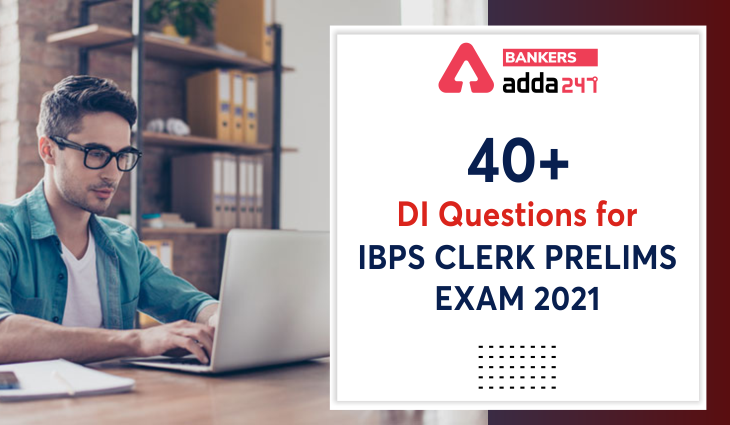

 GA Capsule for SBI Clerk Mains 2025, Dow...
GA Capsule for SBI Clerk Mains 2025, Dow...
 The Hindu Review October 2022: Download ...
The Hindu Review October 2022: Download ...
 World Malaria Day 2025
World Malaria Day 2025



